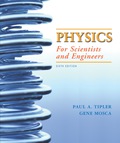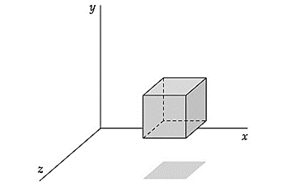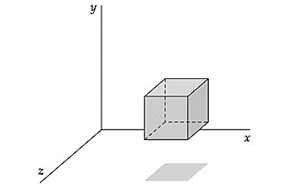
Concept explainers
a.
To Show:The net electric flux of the electric field out of the Gaussian surface is given by
The net electric flux of the electric field out of the Gaussian surface is given by
Given:
A small gaussian surface as shown

Formula Used:
The net flux is given by
Calculations:
The net flux is given by
Using Taylor series expansion
Neglecting the higher than first order
As the electric field is in the x direction
Substituting in equation 1
Conclusion:
The net electric flux of the electric field out of the Gaussian surface is given by
b.
Show that
Given:
A small gaussian surface as shown

Formula Used:
Gauss’s law:
Where, q is the charge enclosed
Calculations:
From part (a)
Equating the two equations
Conclusion:
b.
Show that
Given:
A small gaussian surface as shown

Formula Used:
Gauss’s law:
Where, q is the charge enclosed
Calculations:
From part (a)
Equating the two equations
Conclusion:
Want to see the full answer?
Check out a sample textbook solution
Chapter 22 Solutions
Physics for Scientists and Engineers
- An insulating solid sphere of radius a has a uniform volume charge density and carries a total positive charge Q. A spherical gaussian surface of radius r, which shares a common center with the insulating sphere, is inflated starting from r = 0. (a) Find an expression for the electric flux passing through the surface of the gaussian sphere as a function of r for r a. (b) Find an expression for the electric flux for r a. (c) Plot the flux versus r.arrow_forwardAn infinite, insulating cylinder of radius ri is surrounded by an air gap and a thin, cylindrical conducting shell of radius r2. The insulating cylinder carries constant volume charge density p and the conducting shell carries a constant area charge density o. Use Gauss's law to calculate the quantity f E•dA for the Gaussian shape (a) most appropriate for this problem. (b) distribution). Find the electric field in the region r < ri (inside the volume charge (c) Find the electric field in the region r1 < r < r2 (air gap region) 2.arrow_forward(a) Consider an electric field that is given by E= -2.0-3.0ỹ - 2.02 (Units V/m). Find the flux of the field through a square surface of side length 1 cm that lies in the yz plane. (b) What is the total electric flux through the closed surface whose cross sections are shown below? (a) 4.0 x 10-6 C -3.0 x 10-6 C 5.0 x 10-6 C (b) -2.0 x 10-6 Carrow_forward
- A positively charged cylinder has a uniform volume charge density. Height l is larger than its radius a (1»a). a P a. When Point P is very close to the surface of the cylinder (1>r>a), the electric field there can be derived by treating the cylinder as an = Eŝ. infinitely long one. Suppose that we already measure the electric field at P as charge density in terms of E and a (ŝ is the radial unit vector in the cylindrical coordinate system as defined in the Equation: now use the Gauss's law to find the volume cos o â + sin ø ŷ, - sin ø Âx + cos ø ŷ, î. b. Now we move the detector from Point P to Point Q, which is so far away from the cylinder (R>l>a), that the cylinder can be treated as a point. Based on result in Part (a), find out the electric field at Q (Note that OQ is in the x direction.)arrow_forwardAn insulating solid sphere of radius a has a uniform bulk density ρ and a total positive charge Q. Calculate the magnitude of the electric field at a point outside the sphere.arrow_forwardThere are two concentric cylinders with R1= 0.0056 m and R2= 8R1 with a length of 6.1m. The internal cylinder charge is q=2.7nC and uniformly distributed, the external one is -3q also uniformly distributed. How much is the electric field at r= 4.4R1. Express your answer in N/A to three significant figures.arrow_forward
- An insulating solid sphere of radius a has a uniform volume charge density ρ and carries a total positive charge Q (as shown). (A) Calculate the magnitude of the electric field at a point outside the sphere. (B) Find the magnitude of the electric field at a point inside the sphere.arrow_forwardA solid insulating sphere of radius a=5.0 cm carries a net positive charge of Q=6.0 µC uniformly distributed throughout its volume. Concentric with this sphere is a conducting spherical shell with inner radius b=10 cm and outer radius c=15 cm and having net charge Q2= -8 µC, as shown. The electric field at a point r=12 cm from the center is: Insulator Conductor O 1.3×106 N/C O 3.8×106 N/C 5.0x106 N/C zeroarrow_forwardA cube with edge lengths 1.6 m contains positively charged particles. Consider a Gaussian surface ofexactly the same dimensions surrounding the cube. The electric field caused by the charges is normalto all the faces of the Gaussian cube. If the electric field at each face of the cube has a magnitude of750 N/C, determine the average volume charge density in the cube.arrow_forward
- Consider two thin disks, of negligible thickness, of radius R oriented perpendicular to the x axis such that the x axis runs through the center of each disk. The disk centered at x=0 has positive charge density η, and the disk centered at x=a has negative charge density −η, where the charge density is charge per unit area. What is the magnitude E of the electric field at the point on the x axis with x coordinate a/2? Express your answer in terms of η, R, a, and the permittivity of free space ϵ0.arrow_forwardAn electric field given by = 5.5i - 2.3(y2 + 5.8)j pierces the Gaussian cube of edge length 0.210 m and positioned as shown in the figure. (The magnitude E is in newtons per coulomb and the position x is in meters.) What is the electric flux through the (a) top face, (b) bottom face, (c) left face, and (d) back face? (e) What is the net electric flux through the cube?arrow_forwardQ: A long thin wire carrying a uniform line charge density +λ runs down the center of a long cylindrical tube of radius R carrying a line charge density -2λ distributed uniformly over its surface. Find expressions for the electric field as a function of radial distance r from the axis of the wire for (a) r<R and (b) r>R. Use a minus sign to indicate a field pointing inward. In this question would area, A=2πrL where L is the length of the wire and why is that?arrow_forward
 Physics for Scientists and Engineers: Foundations...PhysicsISBN:9781133939146Author:Katz, Debora M.Publisher:Cengage Learning
Physics for Scientists and Engineers: Foundations...PhysicsISBN:9781133939146Author:Katz, Debora M.Publisher:Cengage Learning Principles of Physics: A Calculus-Based TextPhysicsISBN:9781133104261Author:Raymond A. Serway, John W. JewettPublisher:Cengage Learning
Principles of Physics: A Calculus-Based TextPhysicsISBN:9781133104261Author:Raymond A. Serway, John W. JewettPublisher:Cengage Learning

